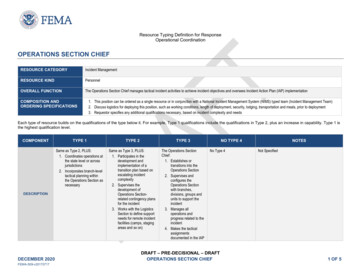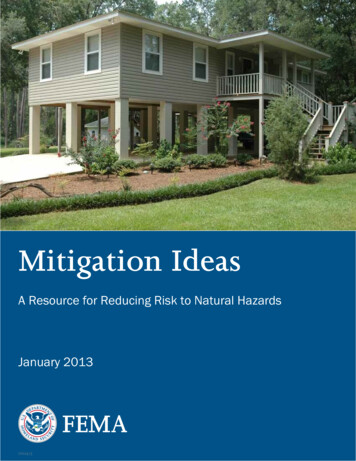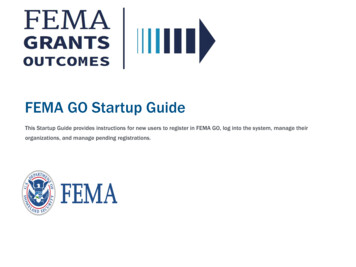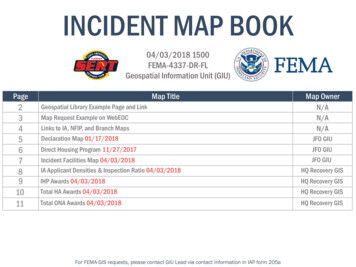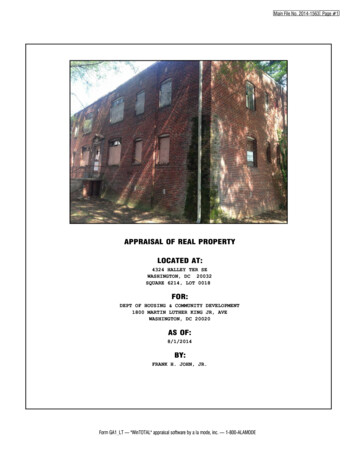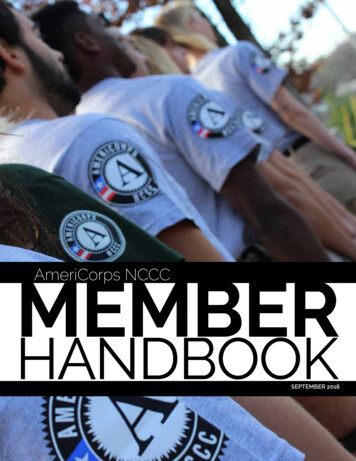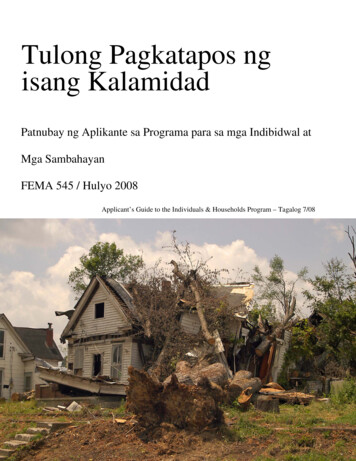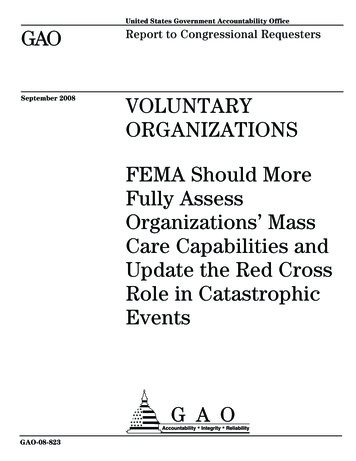
Transcription
2012The State of FEMALeaning forward:Go Big, Go Early, Go Fast, Be Smart.
Letter from W. Craig FugateFEMA AdministratorI am pleased to present “The State of FEMA: Leaning Forward: Go Big, Go Early, Go Fast, Be Smart.” Since 1979, FEMA hasworked collaboratively with our federal partners; state, local, tribal, and territorial officials; the private sector; non-profit andfaith-based groups; and the general public to meet our mission. Thanks to the efforts of the whole community, we standunited and prepared to effectively meet the needs of our citizens during times of crisis – when they are most in need. Thisdocument is intended to highlight FEMA’s guiding principles, the ways we are actively engaged with the emergencymanagement community today, and the work we hope to accomplish in the future.Being successful in emergency response means doing the homework and being equipped to respond to the largest scaledisasters. It means being present early on the scene. It means operating swiftly, while also being smart. We at FEMA aredoing that. And we’re doing what it takes to do all of these things even better.In 2011, FEMA responded to more disasters than any year in its history. The variety and magnitude of each event tested ourcapabilities, as well as the capabilities of communities across the country. While no one hopes to face the same volume ofdisasters in the coming years, it is imperative that we plan accordingly and continue to evaluate our strategic and operationalapproaches to serving the American public.Moving forward in 2012, we will continue to focus on our strategic priorities. We will build on the progress made over the pasttwo years and continue to foster a whole community approach to emergency management. With the completion of our allhazards plans and National Disaster Recovery Framework, development of a National Mass Care Strategy, and implementingthe FEMA Qualification System, we’re strengthening the nation’s capacity to respond to and recover from catastrophicevents. Our strength will also come from our continued partnerships with tribal nations, the disability community, ruralcommunities, and others. We have helped thousands of individuals and communities reduce the economic loss and humansuffering associated with disasters by providing grants for mitigation activities. As part of Presidential Policy Directive 8,FEMA also led the effort to develop and publish a National Preparedness Goal – a national vision of preparedness and how thecountry will work together to approach our shared risks. Finally, we are improving the way we serve disaster survivors byenhancing our ability to improve and innovate based on lessons learned.Projecting further, the Fiscal Year 2013 budget request focuses on achieving success in one of DHS’ core missions: ensuringdomestic resilience to disasters. As such, we place a strong emphasis on funding the key programs that help to ensure that asa nation we will effectively and rapidly respond to and recover from a variety of disasters.2
Table of Contents2011 Performance HighlightsFEMA: Who We Are and Our RoleSection I: Strategic Priorities . 9Foster a Whole Community Approach to Emergency Management Nationally . 10Build the Nation’s Capacity to Respond to and Recover from a Catastrophic Event . 11Build Unity of Effort and Common Strategic Understanding . 12Enhance FEMA’s Ability to Learn and Innovate . 13Case Study: Training Vital to North Dakota Flood Response . 14Section II: FEMA Programs and Missions . 15Response and Recovery .16Response .16Recovery .18Case Study: Getting Back to School in Joplin .19IHP/PA Heat Maps . 20Logistics . 21Readiness and Assessment . 22Protection and National Preparedness . 23State and Local Preparedness . 23Integrated Public Alert and Warning System .26Case Study: Environmental Health Specialists Assist Alabama . 27Federal Insurance and Mitigation .28Case Study: Floodwall Protected Hospital during Tropical Storm Lee . 31United States Fire Administration . 32Mission Support Bureau . 33Section III: 2013 Budget in Brief . 35Section IV: FEMA Statistics and Figures. 413
2011PerformanceHighlightsFEMA responded to a record 98 major disaster declarations, 26emergency declarations, and 112 fire management assistance grant(FMAG) declarations. Among those were tornadoes that devastatedthe town of Joplin, Missouri and severely impacted the southeastregion, Hurricane Irene that impacted 35 million people along theeast coast and record setting flooding in North Dakota.FEMA established the Presidential Policy Directive 8 (PPD-8)Program Executive Office (PEO) to coordinate the implementation ofPPD-8: National Preparedness with state, local and tribal leaders;federal partners; the private sector, non-governmentalorganizations, faith based and community organizations, and thegeneral public. As part of the effort, the first edition of the NationalPreparedness Goal, which sets the vision for preparedness, wasdelivered to the White House.FEMA released the National Disaster Recovery Framework whichdefines how federal agencies will work together to best meet theneeds of states, tribes, and communities in their recovery, byaligning key roles and responsibilities among all our partners.FEMA is conducting town hall meetings around the country withour stakeholders to explain the framework.FEMA provided approximately 2.9 billion (including Staffing forAdequate Fire & Emergency Response (SAFER) grants) in federalpreparedness grants to assist states, territories, urban areas,federally recognized tribes, non-profit agencies, and the privatesector in strengthening our nation’s ability to prevent, protect,respond to, recover from, and mitigate all hazards.4
In 2011 FEMA worked with stakeholders to conduct acomprehensive review of the National Flood Insurance Program(NFIP). By leveraging the expertise of our partners, FEMAbelieves this important effort will ensure that the program canmore efficiently and effectively meet the needs of the public. Theresults of this analysis will inform decisions regarding the futureof the NFIP.FEMA helped train more than 428,000 individuals as part of theCommunity Emergency Response Teams (CERT) program. Overall,more than 1.3 million CERT volunteer hours were recorded in 2011.CERT teams in all 50 states responded to both small and largeincidents providing local support to local citizens first.FEMA supported the Great Central U.S. Shakeout, the largestever, multi-state earthquake drill in the United States, and thefirst major drill to take place along the New Madrid Seismic Zone(NMSZ). More than three million Americans across eleven statesparticipated. Additionally, FEMA led the National Level Exercise2011 which simulated the catastrophic impact of a majorearthquake in the New Madrid Seismic Zone.On November 9, 2011 the Emergency Alert System was tested nationally for the first time. The 30 second nationwide test successfully identified areas of improvement to help strengthen our national emergency communicationsystem. In all, millions of people experienced the test; the largest reach in the Alert’s history. FEMA’s Office ofDisability Integration and Coordination, including our Regional Disability Integration Specialists, worked with thedisability non-profit and advocacy community, especially the deaf and hard of hearing organizations, to spreadawareness of the test.5
Who We Are.Since 1979, FEMA has been the federal government’s lead agency in responding to and recovering from manyof the nation’s greatest moments of crisis. Throughout its history, FEMA has built upon more than 200 years offederal involvement in disasters. All told, FEMA employees have coordinated federal response and recoveryefforts and supported state, local, tribal, and territorial efforts in more than 1,800 incidents.We complete our mission as part of a team. We rely on our federal, state, local, tribal, and territorialgovernment partners; the private sector; nongovernmental entities like faith-based and volunteer groups; andthe public to deliver services and support to people in need.FEMA’s fundamental goal, and the inspiration and motivation for our FEMA employees, is to serve the nationby helping its people and first responders, especially when they are most in need.FEMA is committed to the core values of compassion, fairness, integrity, and respect.Compassion: Understanding and compassion do not only apply to FEMA’s disaster work. FEMA personnelapply these values in dealing with co-workers, response partners, and non-disaster customers.Fairness: FEMA’s goal is that regardless of the outcome, all those with whom FEMA has dealings know thatFEMA professionals listened to their concerns and treated them fairly and with respect.Integrity: FEMA personnel recognize that integrity is their most valuable attribute and display their integrityby always conducting themselves honestly, dependably, credibly, and professionally.Respect: FEMA employees are committed to treating those they serve and those with whom they work, withfairness, dignity, respect and compassion.6
OurGuidingPrinciples“FEMA has never been better:President Obama, DHS SecretaryNapolitano and FEMAAdministrator Fugate along withthe rest of the federal governmenthas treated this storm with atremendous amount ofprofessionalism and preparedness.”Maryland GovernorMartin O’MalleyCNNAugust 27, 2011Guiding principles direct FEMA’s actions and are particularly important whenthe agency is faced with situations for which there is no clear direction. FEMAis committed to providing assistance and conducting all programs, servicesand disaster activity in a manner that includes the whole community and doesnot discriminate on the basis of race, national origin, color, religion, disability,age, sex, limited English proficiency, or economic status. For FEMApersonnel, knowing and applying the guiding principles of teamwork,engagement, getting results, preparation, empowerment, flexibility,accountability, and stewardship helps to ensure that they consistently act inaccordance with FEMA’s core values.Teamwork: FEMA employees are proud to be part of the nation’s emergencymanagement team and recognize that it is only through teamwork that FEMAcan hope to accomplish its primary goal of supporting federal, state, local,tribal, and territorial government partners.Engagement: Effective engagement means that FEMA employees respectand value the professionalism and capabilities that their partners provide andseek new opportunities and innovative ways to include partners in routinedecision-making processes. This is in addition to their collaboration during theexecution of disaster missions.Getting Results: Getting results means identifying what must be achieved interms of outcomes rather than processes. Understanding as clearly as possiblewhat FEMA is trying to achieve improves the likelihood that FEMA personnelwill make the best decisions under extreme pressure inherent during largescale disasters.Preparation: Preparation is the key to achieving the desired results. FEMAmust continually plan, because the agency is guided by the mantra that failingto plan is planning to fail.Empowerment: The nature of FEMA’s responsibilities means that it mustconstantly lean forward and always be prepared to take decisive action. FEMAemployees must be empowered to take actions expeditiously to achievedesired outcomes.FEMA ensures that when communitiesrebuild after disasters they integratethe needs of persons with disabilitiesand others with access and functionalneeds into their community wideplanning initiatives, and strengthentheir ability to prepare for, protectagainst, respond to, recover from andmitigate all hazards.Flexibility: FEMA personnel work in dynamic environments characterized byrapidly changing priorities and ground rules. FEMA is prepared to adjustquickly as risks and stakeholder needs change.Accountability: FEMA employees accept responsibility for accomplishingtheir missions, are transparent in their decision-making, and expect to be heldaccountable for the actions they take.Stewardship: FEMA personnel are public servants entrusted with publicresources to perform a critical mission. They have ethical, moral and legalresponsibilities to protect these resources and ensure they are used effectivelyand for their intended purpose. FEMA employees are also entrusted with theresponsibility to be good stewards of the nation’s natural and culturalresources and take this responsibility very seriously in executing their mission.7
TheFEMACulture“When you see local, state andfederal people cooperating likethis, it really makes adifference.”Alabama GovernorRobert BentleyPoliticoMay 1, 2011FEMA's fundamental goal, and the inspiration and motivation for manyFEMA employees, is to serve the nation by helping its people and firstresponders, especially when they are most in need. FEMA's responsibilitiesfurther help to complement this ethos. Whether supporting state, local,tribal, and territorial governments in responding to and recovering fromdisasters, directly meeting the needs of disaster survivors, supporting thefirst responder community, or making the nation more resilient throughpreparedness or mitigation activities, FEMA employees have a uniqueopportunity and vital responsibility to help others.The FEMA ethos also demands that FEMA employees help citizens andcommunities realize they have the power to help themselves. By focusingon this ethos, FEMA employees can make a real difference to the peopleand communities of this nation.Preparedness: The preparedness mission seeks to reduce the loss of lifeand property and protect the nation by planning, training, exercising,evaluating and building the emergency management profession.Prevention: The prevention mission seeks to avoid, prevent or stop athreatened or actual act of terrorism.Protection: The protection mission seeks to protect our nation’sconstitutional form of government and ensures that a system is in place towarn our citizens of impending hazards.Mitigation: The mitigation mission seeks to reduce or eliminate long-termrisks to people and property from hazards and their effects.Response: The response mission seeks to conduct emergency operationsto save lives and property through positioning emergency equipment,personnel, and supplies; evacuating survivors; providing food, water,shelter, and medical care to those in need; and restoring critical publicservices.FEMA employee Susan Petersonconducts a FEMA for Kids Workshop atthe Middleburgh Elementary School inN.Y. By participating in educationalgames and activities, students learn whatto include in a disaster supply kit, how toprotect pets during a disaster, and whattheir families can do during a disaster.8Recovery: The recovery mission seeks to support communities inrebuilding so individuals, civic institutions, businesses, and governmentalorganizations can function on their own, return to normal life, and protectagainst future hazards.By successfully executing these missions, we support our citizens and firstresponders to ensure that as a nation we work together to build, sustain,and improve our capability to prepare for, protect against, respond to,recover from, and mitigate all hazards.
Section IStrategicPrioritiesFEMA recognizes that we are onlyone member of a broad nationalemergency managementteam—one that includes federal,state, local, tribal, and territorialgovernments, the private sector,nongovernmental organizations,faith-based and communitybased organizations, and theAmerican public. Further, theagency acknowledges that therapid pace of change in the worldcannot be controlled and that theconditions we operate in willcontinue to evolve. At the sametime, experience has taught usthat we must do a better job ofproviding services for the entirecommunity, regardless of theirbackground, demographics, orchallenges. This means planningfor the actual makeup of acommunity, and making sure wemeet the needs of every disastersurvivor regardless of age,economics, or accessibilityrequirements.Addressing these related concernscannot be achieved by simplyimproving what we have alwaysdone – we must fundamentallychange how we go about disasterpreparedness, response, recoveryand mitigation, involving thecommunities we serve directly inthese efforts.9
Foster a Whole Community Approach to EmergencyManagement NationallyFEMA recognizes that it takes all aspects of a community (volunteer, faith,and community-based organizations, the private sector, and the public,including survivors themselves) – not just the government – to effectivelyprepare for, protect against, respond to, recover from, and mitigateagainst any disaster. It is therefore critical that we work together to enablecommunities to develop collective, mutually supporting local capabilitiesto withstand the potential initial impacts of these events, respond quickly,and recover in a way that sustains or improves the community’s overallwell-being.The “A Whole Community Approachto Emergency Management:Principles, Themes, and Pathways forAction” document is intended topromote a greater understanding ofthe FEMA approach and provide astrategic framework to guide allmembers of the emergencymanagement community as theydetermine how to integrate WholeCommunity into their daily practices.Over the last two years, we have made significant progress in fostering awhole community approach to emergency management. Through theMaximum of Maximums initiative, national dialogue and outreach efforts,the whole community approach is now prevalent in the emergencymanagement community. Across the country, we are seeing FEMA andour partners begin to exercise and implement the whole communityapproach and principles in their day-to-day activities.The FEMA Mitigation and Insurance Strategic Plan for 2012–2013,embodies the concept of whole community engagement. The planidentifies specific goals, objectives, and strategies to help us betterengage federal, state, tribal, territorial, and community partners inadvancing mitigation activities. It embraces the reality that it takes allaspects of a community, not just the government, to truly reduce thedevastating impact of disasters.FEMA’s Office of Disability and Integration Coordination and the RegionalDisability Specialists have opened up the dialogue of making all programsand services accessible to all people with disabilities and those with accessand functional needs. They have provided critical support to all levels ofgovernment.A lab technician prepares biologicalmaterials for use in future training atthe Center for Domestic Preparedness(CDP). The CDP will begin usingbiological materials in trainingscenarios in 2012. Several keyhomeland security publications haveidentified the need for enhancedpreparedness for biological attacks.10FEMA has significantly boosted the level of interaction and collaborationwith the broader private sector during disasters by launching a PrivateSector Representative initiative in the National Response CoordinationCenter. To date, six companies have participated in 90-day rotations,including Target, Big Lots, Brookfield Properties, Verizon, Walmart andthe first small business representative, from Strategic PlanningCorporation.To encourage a whole community approach at the state, local, tribal andterritorial levels, FEMA wrote explicit language into the 2011 HomelandSecurity, Emergency Management, and tribal grant programs referencingthe use of funds for private sector engagement. An accompanying privatesector grant supplemental provides detailed ideas on how states mightbenefit from partnering with the private sector in emergencymanagement and ways to use the funds to support successful efforts.
In 2012, FEMA will: Mike Dayton (L) Acting Secretary of theCalifornia Emergency ManagementAgency (CalEMA) and David Ball (R)Disability Integration Specialist forFEMA Region 9 speak at the FEMAbooth set up for the Be Prepared!emergency preparedness event hostedby CalEMA at the Capitol in Sacramento. Leverage the Office of Disability and Integration and Coordination,Office of Equal Rights and Regional Disability IntegrationSpecialists as part of the FEMA team working toward an inclusivemodel of emergency preparedness, response, and recovery.Continue to involve private sector representatives as part of theNational Response Coordination Center to help engage privatesector participation in emergency management, and develop plansto incorporate them into the Regional Response CoordinationCenters.Expand and modernize the Integrated Public Alert and WarningSystem to include more Emergency Alert System Primary EntryPoint Stations and the Commercial Mobile Alert System fordelivering emergency alerts to cellular phones.Continue to strengthen partnerships with tribal nations, faith-basedorganizations, the disability community, rural communities andothers.Exercise with partners to collaboratively prepare for hazards.The 2013 request for increased funding in state and local programs forthe National Preparedness Grant Program of 518,031 will allowgrantees to develop and sustain core capabilities. Enhancing state andlocal capability further strengthens their communities and continues tofoster a whole community approach.FEMA Region 10 partners with the FEMAEmergency Management Institute andthe Boeing Company to conduct a fourday Integrated Emergency ManagementCourse focused on a catastrophic floodevent south of Seattle. More than 150participants from five local communities,Boeing, and the State of Washingtonparticipated.Build the Nation’s Capacity to Respond and Recover from aCatastrophic EventDuring the last two years, we have instituted a forward leaningapproach to “Go Big, Go Early, Go Fast, Be Smart” by focusing on“Maximum-of-Maximums” planning. Key benchmarks for FEMA’sresponse and recovery resulting from a catastrophic event are tostabilize the event to meet the needs of survivors within 72 hours,restore basic services and community functionality within 60 days, andreturn communities to normalcy within five years. The criticaloutcomes for 14 Response and eight Recovery Core Capabilities havebeen quantified and incorporated into the National Preparedness Goalto be implemented through national and regional plans.In 2012, FEMA will: Shelter guests at the Hope PresbyterianChurch in Memphis, Tenn. listen toinformation in Spanish from FEMARegion 4 translator Andres Lugo. FEMAsupplies information in many languages. Develop an all-hazard Federal Interagency Operational Plan inconformance with the new National Preparedness Goal.Develop all-hazard operational plans for each of the ten FEMARegions, including incident-specific annexes for unique catastrophicsituations.Develop a National Mass Care Strategy.Implement the Crisis Management System to improveunderstanding of the common operating picture.11
Only one hurricane hit the U.S. in 2011 butit affected 14 states and more than anestimated 35 million people. HurricaneIrene left her mark all along the east coast,but the non-coastal state of Vermontsuffered flooding that amounted to thestate’s worst disaster ever. FEMA prepositioned commodities and people in all14 states, enhancing communicationsefforts and speeding response. Implement the FEMA Qualification System to strengthen workforceoperations and enhance the reservist program through the disasterworkforce transformation. Develop stronger government-to-government relationships with tribalnations. Build out the components of the National Preparedness System andthe associated National Planning Frameworks and Federal InteragencyOperational Plans for each mission area, the National Training andEducation System, and the National Preparedness Report. Foster a culture of preparedness across the whole community througha campaign to build and sustain preparedness. Enhance monitoring capabilities for radiological and nuclear incidentsto rapidly inform consequence management activities. Conduct modeling and analysis to inform critical decision making andfacilitate rapid incident stabilization during a catastrophic incident forthe Institute for Business and Home Safety and others and enable theagency to effectively message communities and states to adopt andenforce building codes to create more disaster-resilient and sustainablecommunities including compliance to Americans with Disabilities Act(ADA) and federal laws to make communities accessible for all.Build Unity of Effort and Common Strategic UnderstandingJason McNamara, Chief of Staff for FEMA,discusses the new WorkforceTransformation initiative and FEMAQualification System with Region 7employees. All ten of the FEMA regionaloffices hosted similar events to educateand inform the workforce of thesechanges.Region 2 FEMA representatives thankHome Depot store manager as he andother employees are honored with aCertificate of Appreciation for their rolewith hosting community education andoutreach events in the wake of TropicalHurricane's last year.12The nation must manage risk and prepare for, protect against, respond to,recover from, and mitigate against the impacts/consequences of risks tothe health and welfare of the American people. It is essential to develop acommon understanding of the risk landscape to identify mitigation andprevention opportunities across all mission areas, estimate requiredresources, assess gaps, build and sustain capabilities, and plan to deliverthem. Risk based planning is about understanding the broader risklandscape/picture from key perspectives (state, region, national).As part of the implementation of Presidential Policy Directive 8 (PPD-8),FEMA released of the first-ever National Preparedness Goal. The Goalidentifies the core capabilities and capability targets necessary to advanceour national preparedness. It builds extensively on the prior work of manystakeholder groups from around the nation, draws upon lessons learnedfrom large-scale and catastrophic events, and represents input from allstakeholders. It also recognizes that as we work to build a more preparednation, we cannot only look at the role that government plays, we mustalso work with the entire community – both the public and private sectors,faith-based and non-profit organizations, and most importantly the public.
In 2012, FEMA will:Members of AmeriCorps New Jerseyteam pack and assemble health andhygiene kits for distribution to disastersurvivors. AmeriCorps is one of manyorganizations who provide assistance todisaster survivors through thecoordinating efforts of FEMA. Conduct second generation Regional Threat and Hazard Assessmentsto improve and refine understanding of our nation’s greatest risks toprovide a solid risk-based foundation for preparedness and planningefforts. With the National Preparedness Goal complete, continue to work onadditional requirements of PPD-8:o A National Preparedness System Description.o A series of National Frameworks and Federal InteragencyOperational Plans.o A National Preparedness Report.o A campaign to build and sustain preparednessEnhance FEMA’s ability to learn and innovate“I don’t think there is much tomumble and grumbleabout Everybody feels secureabout getting help.”Alabama ResidentAxavier WilsonNew York TimeMay 1, 2011Operational realities have taught us that no matter how much we prepare,it is still impossible to predict exactly what will happen in a disasterenvironment. FEMA’s initiative to enhance our ability to learn andinnovate puts a premium on developing organizational capacity to learnfrom past experience, rapidly orient and apply that learning in currentcontexts, and adapt to quickly changing conditions. FEMA can facilitateorganizational growth by improving its evaluation of operationalperformance in both real world incidents and simulated exercises, andsharing lessons learned best practices, and corrective actions followingevents and exercises throughout the whole community.In 2012, FEMA will: Begin a multi-year effort, working with FEMA’s partners, toupdate and enhance the software and procedures that supporttracking correcti
FEMA released the National Disaster Recovery Framework which FEMA provided approximately 2.9 billion (including Staffing for . system. In all, millions of people experienced the test; the largest reach in the Alert's history. FEMA's Office of . results of this analysis will inform decisions regarding the future of the NFIP.


